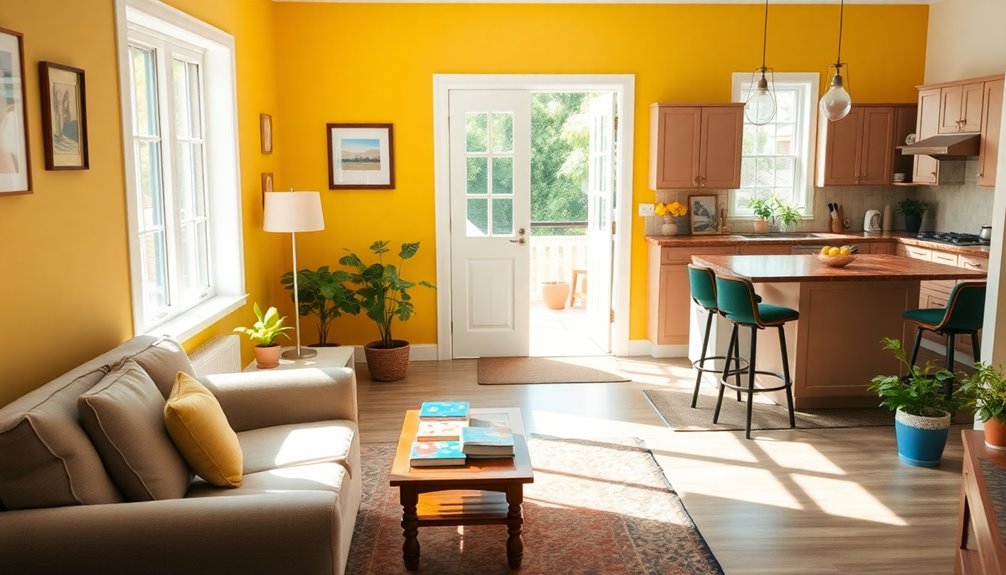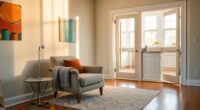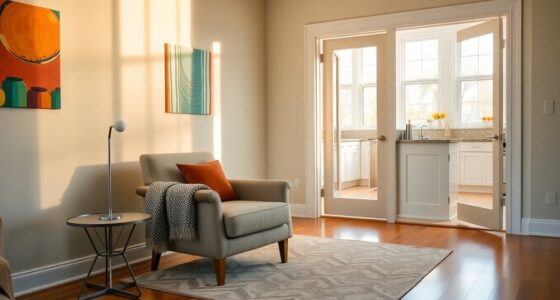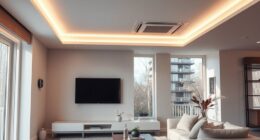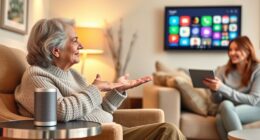To create a safe living space for seniors, consider these essential accessibility features: step-free entryways, wider doorways, bathroom grab bars, non-slip flooring, proper lighting, emergency response systems, adjustable kitchen counters, stable furniture, outdoor ramps, and clear pathways. These modifications enhance mobility and reduce hazards, allowing for greater independence. Implementing these changes guarantees safety and comfort at home. Explore further to discover how each feature can be tailored to your specific needs and enhance daily living. Additionally, incorporating technology, such as voice-activated devices and smart home systems, can greatly facilitate daily tasks and improve overall security. Families should also assess the need for elderly safety accessibility enhancements based on individual capabilities and preferences, ensuring that each person’s unique situation is taken into account. By prioritizing these features, we can foster an environment that empowers seniors to live with dignity and peace of mind.
Key Takeaways
- Step-free entryways and ramps ensure safe access to different home levels, accommodating wheelchair users and enhancing mobility for seniors.
- Grab bars and handrails in bathrooms and hallways prevent falls, providing essential support for elderly individuals.
- Non-slip flooring in kitchens and bathrooms reduces slipping risks, promoting a safer environment for daily activities.
- Well-lit pathways, including motion-activated lights, improve visibility and reduce the risk of accidents during nighttime navigation.
- Personal emergency response systems (PERS) provide immediate access to help, ensuring seniors can quickly reach assistance when needed.
What Is an Accessible Home?
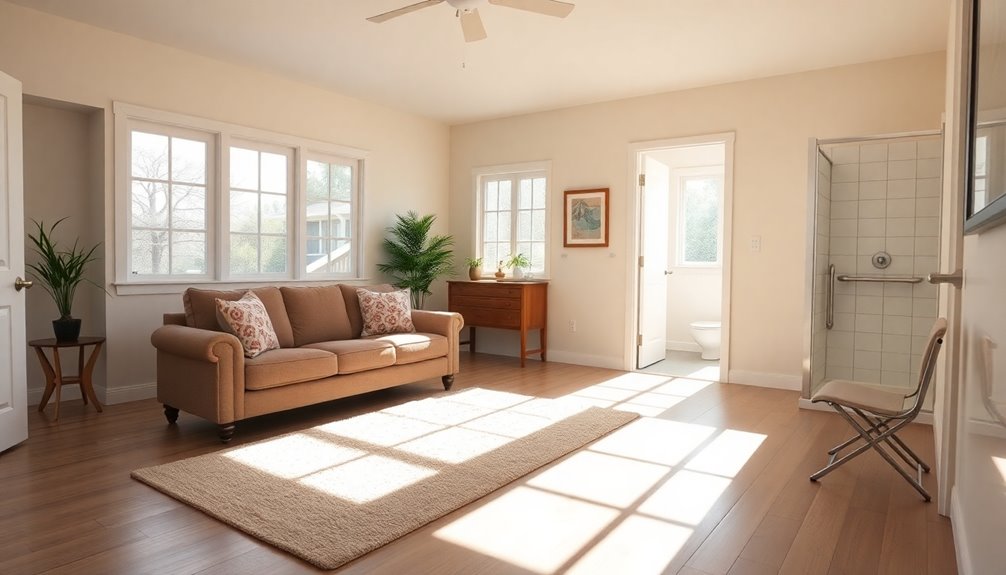
An accessible home is designed to make life easier for individuals with disabilities, especially those who use wheelchairs.
An Accessible Home Environment incorporates fundamental features that address safety concerns and enhance the quality of life for older adults. Common modifications include step-free entryways, wider doorways, and first-floor bathrooms, which greatly reduce the risk of falls.
Sadly, only 10% of U.S. homes have these critical accessibility features, leaving many to navigate daily challenges.
By making necessary home modifications, you not only guarantee comfort and safety but also promote independence for older adults.
Embracing accessible design is crucial, as it allows everyone to live confidently and enjoy their homes without barriers.
Wheelchair Accessibility
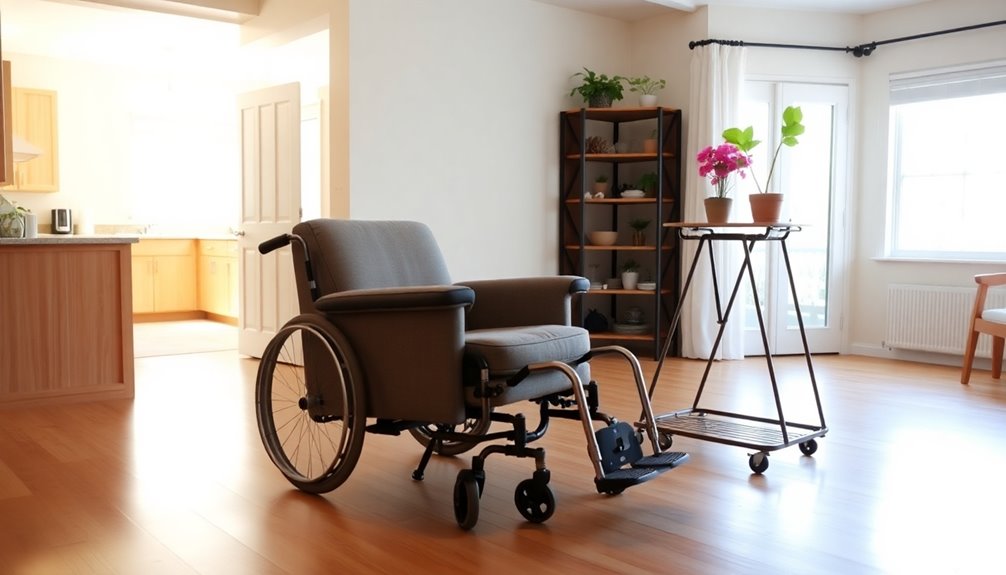
Wheelchair accessibility is vital for creating a safe and functional environment for those who rely on mobility aids.
You'll want to guarantee your home features wide doorways, as standard ones are often too narrow for wheelchair users. Installing sturdy ramps with a gradual slope is essential for safe access to different levels of your home.
Additionally, rearranging furniture to create clear, wide pathways enhances navigation and overall home safety. The Americans with Disabilities Act (ADA) recommends doorways to be at least 32 inches wide to accommodate wheelchair users comfortably.
For major renovations, consider obtaining multiple written bids from qualified contractors to receive personalized recommendations and make informed decisions. This will help you achieve ideal wheelchair accessibility in your living space.
Bathroom Modifications
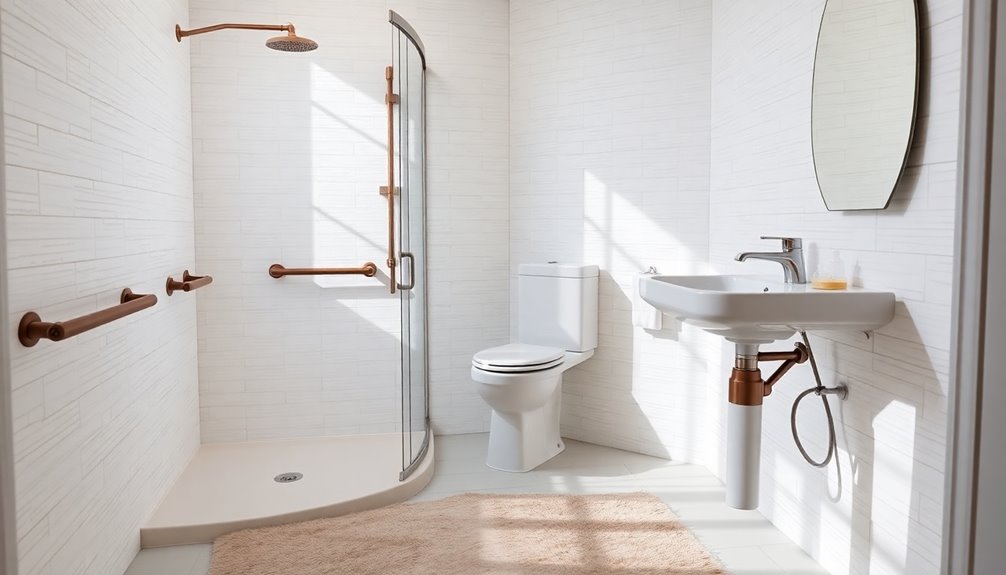
When it comes to bathroom modifications, installing handrails and grab bars can make a world of difference in preventing falls.
You'll also want to contemplate non-slip flooring options to enhance safety on wet surfaces.
Plus, a walk-in shower can provide easier access and a more comfortable bathing experience for anyone with mobility challenges.
Handrails and Grab Bars
Safety in the bathroom is paramount for seniors, and installing handrails and grab bars is a key step in creating a secure environment. By placing grab bars in the shower, tub, and near the toilet, you can greatly reduce the risk of falls. These installations provide essential support during shifts between standing and sitting, enhancing overall safety.
Handrails should be securely mounted to assist individuals with mobility challenges in navigating steps or uneven surfaces. Regularly assess the placement and effectiveness of these features to guarantee they're positioned most effectively.
Additionally, consider combining grab bars with walk-in showers to facilitate easier access and further prevent accidents. With these modifications, you can create a safer bathroom space for yourself or your loved ones.
Non-Slip Flooring Options
Creating a safe bathroom environment goes beyond just installing handrails and grab bars; choosing appropriate flooring plays a vital role too. Non-slip flooring options, like textured vinyl or rubber, greatly reduce the risk of slips and falls, which are common among elderly individuals.
To enhance safety, consider the following:
- Install non-slip mats or adhesive strips in bathtubs and showers.
- Regularly inspect and maintain non-slip surfaces to confirm they remain effective.
- Choose flooring that promotes overall accessibility and safer movement.
Walk-In Shower Benefits
Walk-in showers offer a practical solution for seniors and those with mobility challenges, as they eliminate the need to navigate over high bathtub edges.
By incorporating non-slip flooring, these showers considerably enhance safety, reducing the risk of slips and falls during bath time.
Adding grab bars provides extra support, making shifts between standing and sitting much easier and safer.
Handheld showerheads allow you to shower comfortably while seated, giving you control over the water flow.
Adequate lighting can also be integrated, improving visibility for elderly users who may have visual impairments.
With these features, walk-in showers guarantee accessibility and promote a safer, more enjoyable bathing experience tailored to your needs. Additionally, regular inspections can help ensure that all safety features are functioning properly and providing the intended support.
Tripping Hazard Removal
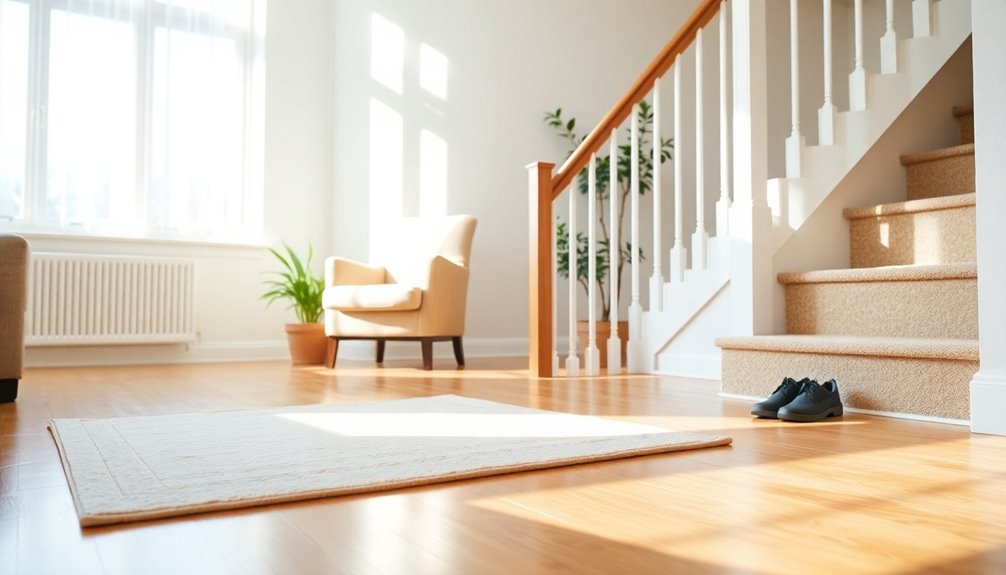
Since nearly 30% of seniors experience falls each year, removing tripping hazards in the home becomes essential.
To create a safer environment, focus on these key areas:
- Secure or remove loose rugs: These can easily cause trips, so either fix them in place or eliminate them altogether.
- Keep walkways clear: Guarantee that hallways and pathways are free of clutter, electrical cords, and furniture to prevent accidental falls.
- Inspect and repair damaged flooring: Regularly check for loose tiles or uneven surfaces, and fix any issues immediately.
Additionally, installing non-slip surfaces in kitchens and bathrooms can drastically reduce the risk of slipping on slippery floors.
Proper Lighting and Visibility
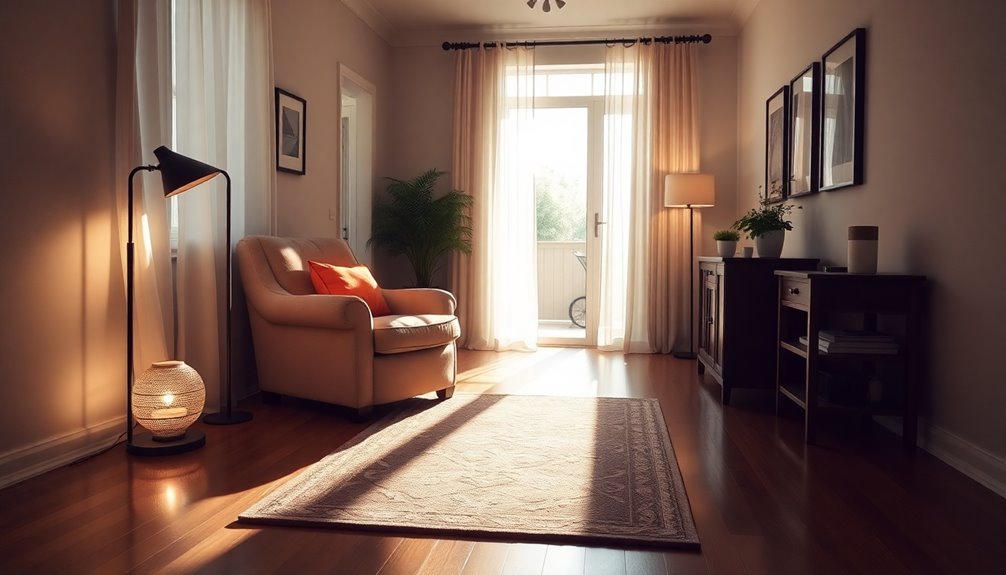
Proper lighting is essential for creating well-lit pathways in your home, especially for safe navigation.
Consider installing motion-activated lights in key areas to guarantee you always have illumination when you need it.
Well-lit Pathways
Good lighting is vital for creating safe pathways in your home, especially as you age.
Well-lit pathways greatly reduce the risk of accidents and help prevent falls, which are common among older adults.
To guarantee your home safety is critical, consider these steps:
- Install brighter, energy-efficient bulbs in hallways and staircases to enhance visibility.
- Use night lights in bedrooms and bathrooms to guide you during late-night trips.
- Regularly check and replace bulbs to maintain proper lighting throughout your living spaces.
- Keeping air purifiers running continuously can also improve indoor air quality, which is essential for optimal usage timing.
Motion-Activated Lighting
While well-lit pathways are essential for safety, motion-activated lighting takes visibility to the next level.
These systems automatically illuminate key areas in your home, like hallways and staircases, when they detect movement. This feature not only enhances visibility but also greatly reduces the risk of falls, especially during nighttime.
Studies show that well-lit environments can decrease fall risks by nearly 50%, making motion-activated lights a must-have for safe elderly living.
You won't have to fumble for light switches, as these lights operate effortlessly. Plus, with smart home technology, you can easily control and program them to suit your individual needs.
Additionally, ensuring safety from falls can be further supported by implementing other accessibility features throughout the home.
Investing in motion-activated lighting is a smart choice for safety and convenience.
Smart Home Technology Solutions
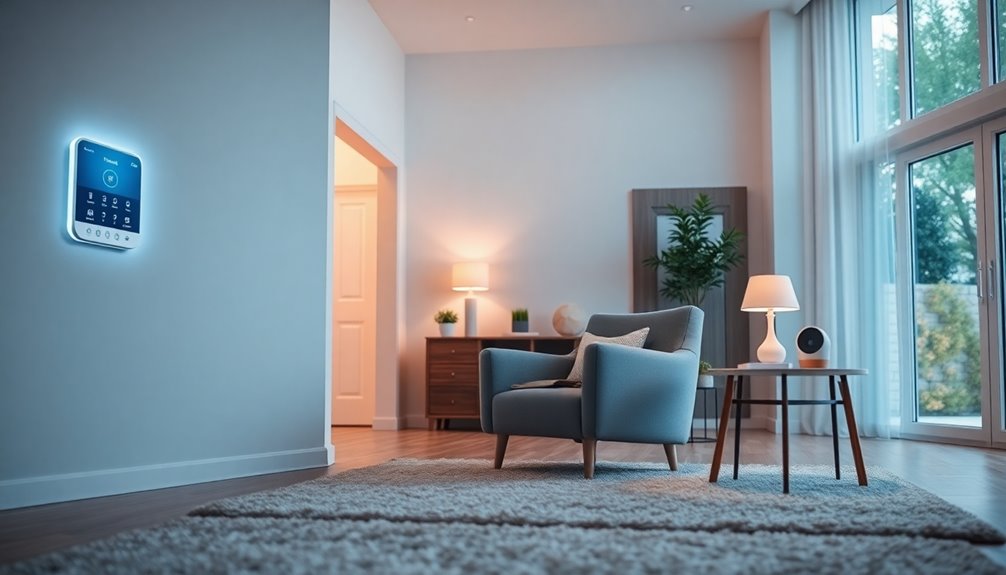
As you explore ways to enhance the living environment for seniors, smart home technology solutions offer a range of features that greatly improve safety and convenience.
These smart home devices can transform daily living by incorporating:
- Voice Commands: Control lighting, thermostats, and appliances effortlessly without moving.
- Fall Detection Devices: Automatically alert emergency services if a fall is detected, ensuring timely assistance.
- Proper Lighting: Use motion-activated lights to illuminate pathways, reducing fall risks at night.
Additionally, smart home security features allow seniors to monitor their home via mobile devices, enhancing their sense of security.
Programmable thermostats help maintain a comfortable indoor climate, essential for seniors with specific health needs. Furthermore, the integration of smart utilities can help manage energy consumption, providing added convenience and efficiency for elderly living.
These advancements not only ease daily tasks but also provide peace of mind for seniors and their healthcare providers.
Emergency Response Systems
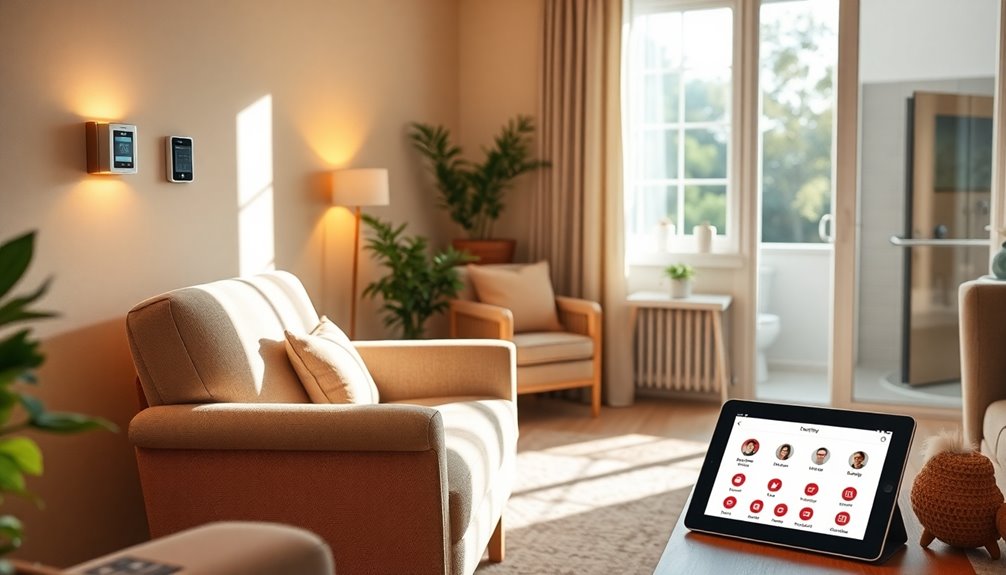
When it comes to safety, having quick access to help can make all the difference.
Wearable alert devices, like pendants or wristbands, let you call for assistance instantly, giving you peace of mind.
With these emergency response systems in place, you can maintain your independence while feeling secure at home.
Quick Access Help
Emergency response systems (PERS) are essential for seniors who want to maintain their independence at home, as they provide immediate access to help with just the push of a button.
These systems offer quick access help, ensuring you're never far from assistance.
Here are three important features to evaluate:
- Medical alert devices: These allow you to call for help instantly.
- Fall detection technology: Many systems automatically alert emergency services if a fall is detected.
- Safety alarms: These enhance your security by reducing the time it takes to receive assistance.
Wearable Alert Devices
Wearable alert devices offer seniors a reliable way to call for help at a moment's notice, enhancing their safety and independence.
These personal emergency response systems (PERS) provide peace of mind by allowing you to quickly alert emergency responders with just the push of a button. Many devices feature fall detection technology, automatically notifying services if you experience a fall, which is vital for those living alone.
Equipped with GPS tracking, these devices help caregivers locate you if you wander or feel disoriented outside. Two-way communication options enable direct conversation with emergency responders, ensuring you get the help you need.
With mobile-compatible designs, you can stay safe whether you're at home or on the go, promoting your independence.
Adjustable and Senior-Friendly Kitchen Design
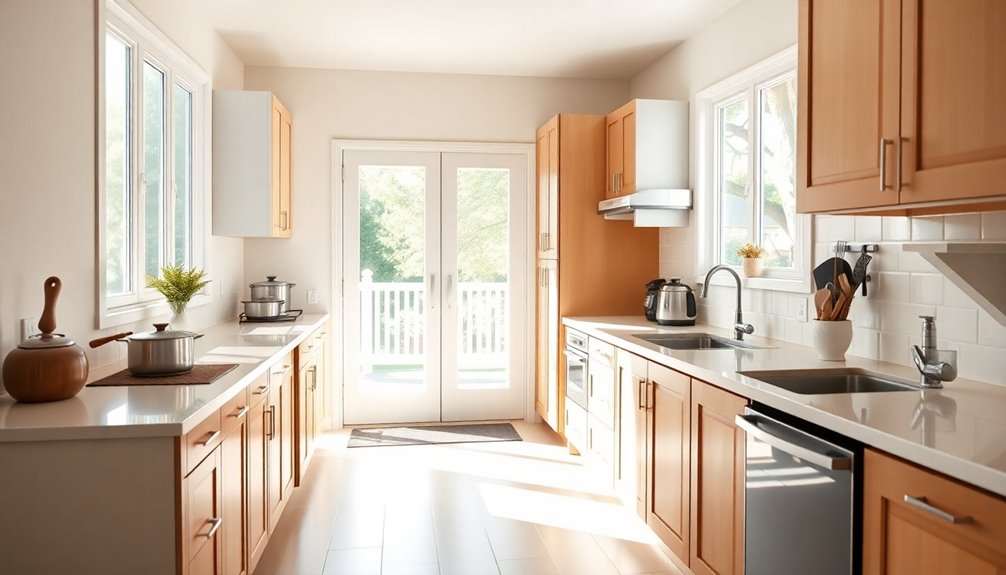
Creating an adjustable and senior-friendly kitchen design can transform cooking into a more enjoyable and accessible experience for elderly individuals. Here are three essential features to evaluate:
- Lower countertops: These allow seniors to prepare meals without straining or reaching excessively high surfaces.
- Pull-out shelves: Incorporating these in cabinets enhances storage accessibility, making frequently used items easy to reach.
- Appliances with simple controls: Look for those with large buttons and clear labels to reduce confusion and increase safety.
Additionally, assess adjustable-height kitchen tables to accommodate seniors in wheelchairs and implement safety features like automatic shut-off functions on stoves. Incorporating energy-efficient appliances can further enhance safety and reduce utility costs, making the kitchen more suitable for elderly users.
Together, these elements create a practical and inviting kitchen space for everyone.
Bedroom and Living Area Adaptations

An inviting bedroom and living area can greatly enhance the quality of life for seniors.
Consider using adjustable beds to help you find comfortable positions, making it easier to get in and out of bed independently.
Choose furniture with rounded edges to reduce injury risks during falls, creating safer living spaces.
Adequate lighting is essential; it improves visibility and minimizes accident risks, especially in high-traffic areas.
Opt for stable furniture design to prevent tipping hazards, giving you confidence as you navigate your surroundings.
Finally, install easy-to-reach outlets and switches, so you can operate devices and adjust your environment with minimal effort.
Additionally, incorporating Alzheimer bracelets can enhance safety and peace of mind for seniors living with cognitive challenges.
These adaptations can make your home a safer, more enjoyable place to live.
Outdoor Accessibility Features
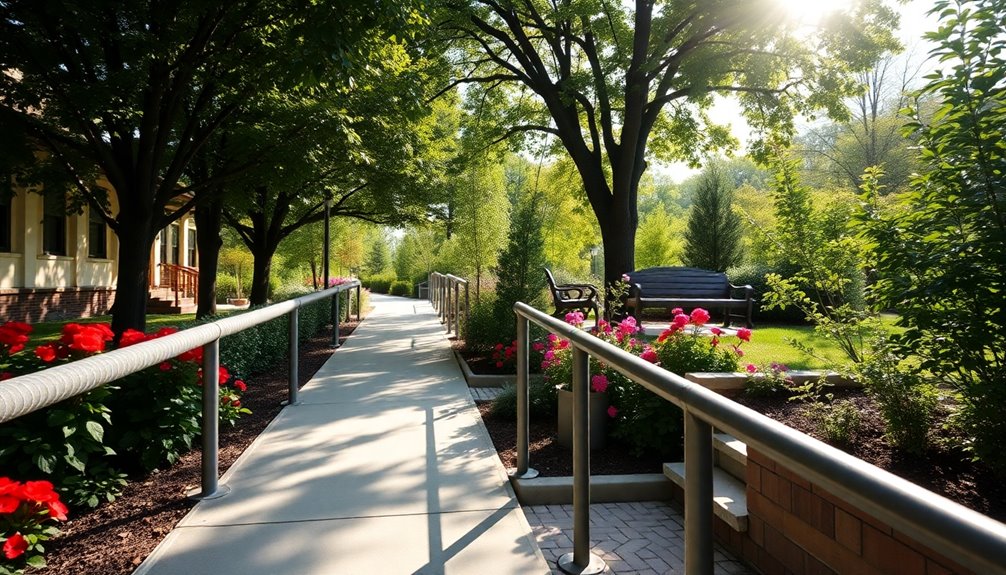
When planning outdoor spaces for seniors, it's vital to prioritize accessibility features that enhance mobility and safety.
Consider incorporating these key elements:
- Wheelchair ramps: Guarantee safe access to entryways, making it easier for those using mobility aids.
- Handrails: Install handrails along outdoor steps and ramps to provide support as seniors navigate different levels.
- Non-slip surfaces: Use non-slip materials on patios and walkways to reduce slip hazards, especially in wet conditions.
Additionally, confirm pathways are wide and well-lit, promoting independence while minimizing accident risks. Adequate lighting near entrances and walkways is significant for visibility during evening hours. Regular home cleaning can also support a safer outdoor environment by removing debris that could lead to accidents.
Frequently Asked Questions
What Are the 4 Aspects of Accessibility?
The four aspects of accessibility are physical access, sensory access, cognitive access, and communication access.
You'll find that physical access includes features like ramps and wide doorways, making movement easier.
Sensory access enhances visibility and sound for those with impairments.
Cognitive access focuses on clear signage and intuitive layouts to help navigate spaces.
Finally, communication access guarantees everyone can share and receive information effectively, promoting inclusivity and understanding in various environments.
What Are 3 Essentials for Accessible Content What Factors Come Into Content Accessibility?
To create accessible content, you need to focus on three essentials.
First, guarantee it's perceivable; use clear text, descriptive alt text for images, and high-contrast colors.
Next, make it operable by allowing navigation through various devices, like keyboards and touchscreens.
Finally, aim for understandability; use straightforward language and consistent structure.
Regularly testing your content with users who've disabilities will help identify barriers, improving overall accessibility.
What Are the 3 Aspects of Accessibility?
The three aspects of accessibility are physical, sensory, and cognitive.
Physical accessibility involves features like ramps and wide doorways that accommodate mobility aids.
Sensory accessibility addresses visual or hearing impairments with design elements such as contrasting colors and auditory signals.
Finally, cognitive accessibility guarantees spaces are easy to navigate and understand, often using clear signage and simplified layouts.
What Are the 5 A's of Senior Friendly Transportation Availability Adaptability Accessibility Affordability and Approachability?
When considering senior-friendly transportation, focus on the five A's: availability, adaptability, accessibility, affordability, and approachability.
You need reliable options that are consistently available, and services should be adaptable to your unique needs, including mobility aids.
Transportation should be accessible with necessary features like ramps and low floors.
It's essential that costs remain affordable, and staff should be approachable, trained to assist you with care, creating a welcoming environment for travel.
Conclusion
Creating an accessible home isn't just about meeting needs; it's about enhancing quality of life. By implementing these essential features, you can guarantee safety and comfort for the elderly. Think of it like upgrading from a flip phone to a smartphone—it's all about making life easier and more enjoyable. With thoughtful modifications, you can empower independence and provide peace of mind for both you and your loved ones. Embrace these changes; they're the key to a safer future!
